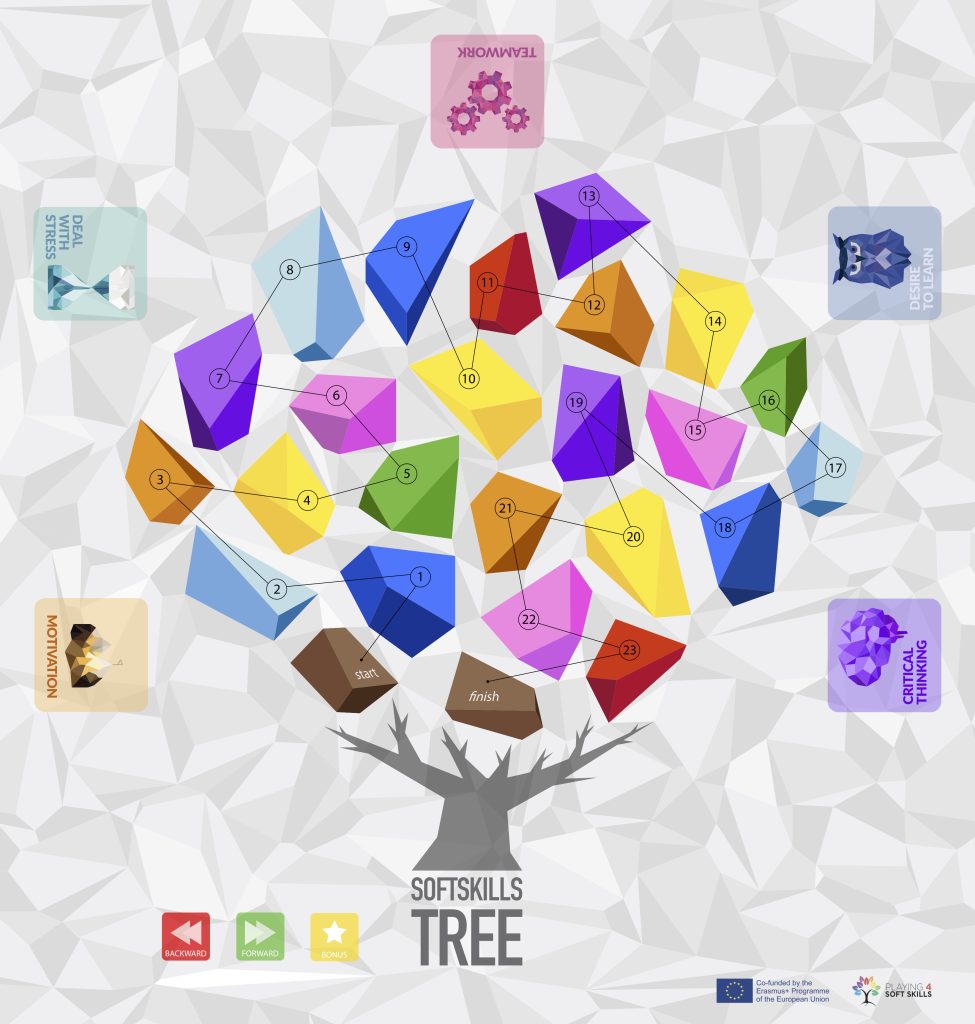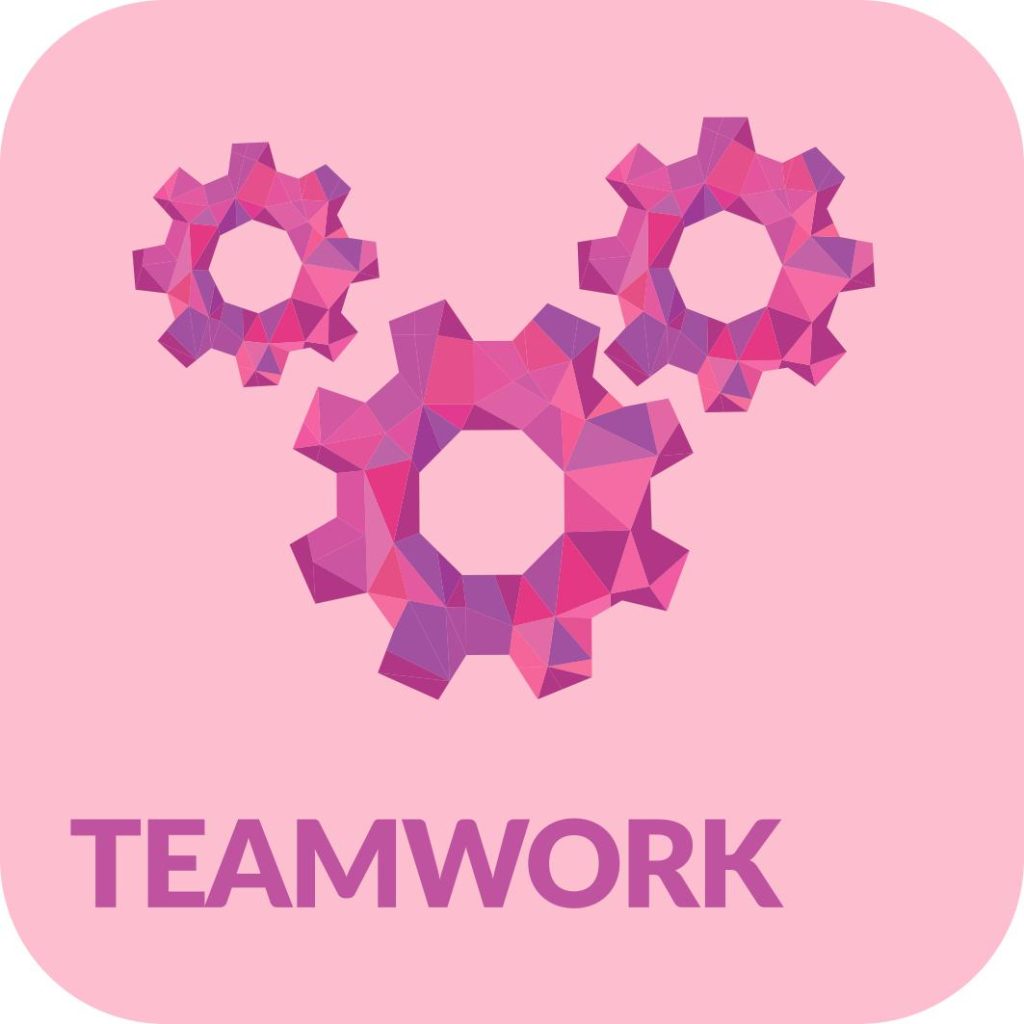Educational Objective: to activate Soft Skills by facing all the challenges you encounter on the path
“Soft Skills Tree” is a board game for youngsters allowing them to activate and train 5 soft skills: teamwork, dealing with stress, motivation, desire to learn and critical thinking.
Based on the results of specific questionnaires that can be consulted in the Soft Skills Evaluation Report, this game has been designed following the preferences of students, teachers and employers: the results of the questionnaire made it possible to identify the 5 most important transversal skills and bridge the gap between the skills acquired at school and those required by the job market.
The choice of the board game as an informal strategy reflects the experience of the partners involved in the co-design process and their decision to adopt an alternative tool to digital games: board games were in fact in second place among the game modes preferred by young people who took part in the survey.
The Goose Game pattern was chosen among the various historical games as the most flexible scheme to be reworked and reloaded with the contents and topics related to the project. The image of the tree as a symbol of growth and adaptation was chosen as the visual of the game board, on which a journey in stages is developed: each box identifies a challenge players face along the way. These playful tasks, related to the activation of soft skills, will train young participants by stimulating them to interact and question themselves, in view of the work environment they will encounter after their studies.
The board game
A game is a social production which reflects the culture of belonging. (Parlebas, 1999)
As such, “Soft Skills Tree” reflects the joint research of all the project partners with the valuable contribution of different professional skills.
The practice of board games is a true exercise of respect for the common rules, those allowing us to live in a democratic society. Playing implies acceptance of the rules and induces respect for other players, either winners or losers. A player who agrees to lose a game channels his frustration and reflects on the strategy he has chosen; therefore, it is a way to educate in the critical analysis of one’s decisions.
An ancient Egyptian legend tells that the first game was invented by a divinity and it was exactly a board game. This story proves that, since the dawn of time, the game has always been a central element in the life of men. Many times the game appears in the myths of ancient Greece, as well as across the Indian civilization, in the stories describing the previous life of the Buddha as a dice player.
As a result, the myths of different civilizations show how much the board game has always been considered a primary element in the foundation of life.
The Goose Game pattern
The Goose Game is a board game whose origins are very ancient. According to the testimony of Pietro Carrera, this board game appeared around 1580 among the gifts sent by Francesco dei Medici, Grand Duke of Tuscany, to Philip II King of Spain.
The Italian origin of this path game is assured but we still do not know exactly who the designer is. To date, the oldest specimen of this game is from Lyon and dates back to 1601. From 1700 to today, the subjects of the Goose Game are still created with educational and didactic intentions. Over time, the board of this game has been characterized by boxes picturing scenes of very different topics such as heroic virtues of Kings, moments of monastic life, passages from the Old Testament, mythological figures, historical periods, the lives of illustrious characters, European countries, fairy tales… In fact, the iconography of the Goose Game board is very diverse and, as a proof of this versatility of structure, there is a museum in Rambouillet (France) dedicated exclusively to this game, where more than 2.500 boards are collected, dealing with many different themes. With the passing of centuries, the Goose Game has also been used as an advertising tool for political propaganda and above all as a support for teaching in schools.
But why the goose? In history as well as in mythological and folk tales, the goose has always been a symbol of wisdom, a character who holds knowledge and provides guidance. It appears in Perrault’s fables, in the tombs of the pharaohs, in the songs of Homer and in the tales of the ancient Romans.
The Goose Game was chosen as the reference pattern to design “Soft Skills Tree” game because in this model luck is able to counteract the excessive difference in skills that is created when the game mechanics are mainly entrusted to strategy and favor only the best participants. In the Goose Game model players begin a path, a kind of symbolic journey, full of adventures between boxes depicting happy and unhappy symbols, learning to go forward, backwards, jumping ahead, etc… Similarly, in the Soft Skills Tree game the addition of challenges to be faced in each box is decisive for balancing the case, activating different transversal skills and increasing the awareness of participants as they progress on the board.

The visual design: from the tree to the net
Our game is dedicated to the topic of Soft Skills and we decided to take inspiration from the image of a tree to create the board.
Trees are extraordinary examples of living species that adapt to the environment. The shape of the crown and trunk of a tree define its physiognomy which is called posture and is typical of each species. By observing different trees it is easy to realize how their posture is the first useful element in order to recognize them. However, the posture can sometimes be completely different from what the general rule would tell: some trees, in fact, can be much lower than the common ones and even curved towards the ground, due to the living conditions in hostile environments, such as the exposure to the wind or for the lack of water or soil nutrients.
The iconography of the tree in the visual design of this game is strongly inspired by the values of prosperity, growth and adaptation to the future, which recalls the aim of the Playing 4 Soft Skills project: increase awareness and facilitate activation of soft skills through play in order to better prepare young people to enter the job market.
This symbolism is recalled in the project logo, designed together by all partners: a tree with leaves of different colours meaning that developing a wide range of soft skills will be enriching for anyone who will use the game.
The game board takes up this inspiration, expanding the crown of the tree and transforming it into a network, a topic widely discussed during the realization of the visual co-design: this graphic layout wants to represent the connections between personal growth and the outside world, with which young people will measure themselves by entering the world of work.
The board of Soft Skills Tree game proposes a journey in different stages in order to cross the challenges in an abstract and more contemporary foliage that evokes precious gems, similar to buds in botany, which are precious vegetative organs from which leaves, other branches and flowers can originate. The same gems, during the game, will mature and symbolically shine like the milestones of a mind map on the soft skills, to be played first of all as a team, and then be analyzed more critically later together with the class group.

Soft Skills Tree will be tested in March in Malaga during the leanring activities with the Latvian school Rīgas Tūrisma un radošās industrijas tehnikums and the Escuela de Arte San Telmo.
After the playtests the game will be available on the site of the project to download for free and to play in teams or individually thanks to the APP in progress!
Sources:
- Antonio di Pietro, Luciano Franceschi, Giocare ai tavolieri – Kaleidos, Faenza, 2009
- Walter Nuccio, La progettazione dei giochi da tavolo – Strumenti, tecniche e design pattern – Mursia, Milano, 2019
- Emanuele Coccia, La Vita delle Piante – Metafisica della Mescolanza (English edition: The Life of Plants – A Metaphysics of Mixture) – Il Mulino, Milano, 2018
- Jean-Jacques Rousseau, Atlante di botanica elementare (original title: Atlas de botanique élémentaire) – L’Ippocampo, Parigi, 2021
- Didier Van Cauwelaert, Le emozioni nascoste delle piante – Come si esprimono, comunicano e interagiscono i vegetali (original title: Les émotions cachées des plantes) – Feltrinelli, Parigi, 2017
- Francis Hallé, Atlante di botanica poetica (Original title: Atlas de botanique poétique – English edition: Atlas of poetic botany) – L’ippocampo, Parigi, 2018





